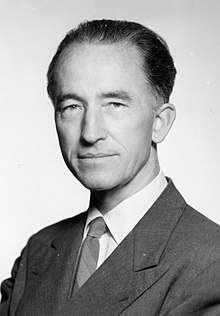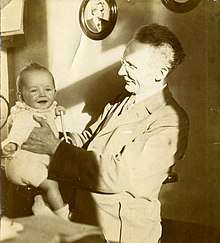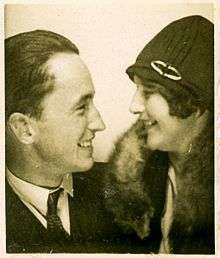Jacob Bjerknes
Jacob Aall Bonnevie Bjerknes (/ˈjɑːkəb ˈbjɜːrknɪs/ in English; 2 November 1897 – 7 July 1975) was a meteorologist.[1][2]
Jacob Bjerknes | |
|---|---|
 | |
| Born | 2 November 1897 Stockholm, Sweden |
| Died | 7 July 1975 (aged 77) Los Angeles, United States |
| Nationality | Norwegian / American |
| Citizenship | Norwegian / American |
| Known for | The Development of Modern Weather Forecasting, Bergen School of Meteorology El Nino |
| Scientific career | |
| Fields | Meteorologist |
| Institutions | University of California, Los Angeles |
| Influences | Vilhelm Bjerknes |


Background
Jacob Aall Bonnevie Bjerknes was born in Stockholm, Sweden. His father was the Norwegian meteorologist Vilhelm Bjerknes, one of the pioneers of modern weather forecasting. His paternal grandfather was Norwegian mathematician and physicist Carl Anton Bjerknes. His maternal grandfather was Norwegian politician Jacob Aall Bonnevie, after whom he was named.[3][4]
Professional career
Bjerknes was part of a group of meteorologists led by his father, Vilhelm Bjerknes, at the University of Leipzig. Together they developed the model that explains the generation, intensification and ultimate decay (the life cycle) of mid-latitude cyclones, introducing the idea of fronts, that is, sharply defined boundaries between air masses. This concept is known as the Norwegian cyclone model.[5]
Bjerknes returned to Norway in 1917, where his father founded the Geophysical Institute, University of Bergen in Bergen. They organized an analysis and forecasting branch which would evolve into a weather bureau by 1919. The scientific team at Bergen also included the Swedish meteorologists Carl-Gustaf Rossby and Tor Bergeron. As pointed out in a key paper by Jacob Bjerknes and Halvor Solberg (1895-1974) in 1922, the dynamics of the polar front, integrated with the cyclone model, provided the major mechanism for north-south heat transport in the atmosphere. For this and other research, Jacob Bjerknes was awarded the Ph.D. from the University of Oslo in 1924.[6]
In 1926, Jacob Bjerknes was a support meteorologist when Roald Amundsen made the first crossing of the Arctic in the airship Norge. In 1931, he left his position as head of the National weather service at Bergen to become professor of meteorology at the Geophysical Institute at the University of Bergen. Jacob Bjerknes lectured at the Massachusetts Institute of Technology during the 1933-1934 school year and emigrated to the United States in 1940 where he headed a government-sponsored meteorology annex for weather forecasting, at the department of physics of the University of California, Los Angeles. During the second world war Bjerknes served the US armed forces and serving as a colonel in the US Air Force he helped find the best dates for the Atomic bombings of Hiroshima and Nagasaki.[7]
Bjerknes founded the UCLA Department of Meteorology (now the Department of Atmospheric and Oceanic Sciences). As a professor at the University of California, he was the first to see a connection between unusually warm sea-surface temperatures and the weak easterlies and heavy rainfall that accompany low-index conditions. At UCLA, Bjerknes and fellow Norwegian-American meteorologist, Jorgen Holmboe, further developed the pressure tendency and the extratropical cyclone theories.
In 1969, Jacob Bjerknes helped toward an understanding of El Niño Southern Oscillation, by suggesting that an anomalously warm spot in the eastern Pacific can weaken the east-west temperature difference, disrupting trade winds, which push warm water to the west. The result is increasingly warm water toward the east.[8]
Personal life
In 1928, he married Hedvig Borthen (1904-1998). They were the parents of two children. He died on 7 July 1975 in Los Angeles, California.
Honors and awards
He was made an Honorary Member of the Royal Meteorological Society in 1932 and a member of both the Norwegian Academy of Science and Letters and the Royal Swedish Academy of Science in 1933.
- Royal Meteorological Society - Symons Gold Medal (1940)
- American Geophysical Union - William Bowie Medal (1945)
- Knight 1st Class of the Royal Norwegian Order of St. Olav (1947).
- Swedish Society for Anthropology and Geography - Vega medal (1958)
- World Meteorological Organization - International Meteorological Organization Prize (1959).[9]
- American Meteorological Society - Carl-Gustaf Rossby Research Medal (1960)
- National Medal of Science (1966)
References
- Jacob Bjerknes - the Synthesizer Archived 15 April 2011 at the Wayback Machine (University of Washington)
- Jacob Bjerknes (Norsk biografisk leksikon)
- The Life and Science of Jacob Bjerknes (Creighton University Department of Atmospheric Sciences)
- Carl Anton Bjerknes (Norsk biografisk leksikon)
- Jacob Aall Bonnevie Bjerknes (1897–1975) Archived 19 August 2011 at the Wayback Machine (American Geophysical Union)
- Halvor Solberg (Store norske leksikon)
- Magasinet, supplement to Dagbladet, 11 February 2014. pp 14-24
- Nova (1998). "1969". Public Broadcasting Service. Retrieved 24 July 2009.
- "Winners of the IMO Prize". World Meteorological Organization. Archived from the original on 22 November 2015. Retrieved 9 December 2015.